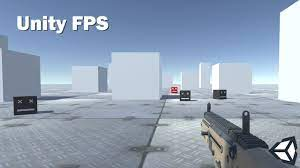Exploring FPS Unity: A Thrilling Journey into First-Person Shooter Game Development
Introduction: Welcome, fellow gaming enthusiasts and aspiring game developers! Today, we embark on an exciting adventure into the realm of FPS Unity. First-person shooter games have captivated players for decades, offering immersive experiences and adrenaline-fueled action. Unity, one of the most popular game development engines, provides a powerful toolkit for creating FPS games. In this blog post, we will dive deep into the world of FPS Unity, covering essential aspects, tips, and tricks to help you get started on your journey to creating your own thrilling FPS masterpiece.
- Getting Started with Unity: To begin our exploration, it's important to familiarize ourselves with Unity and its features. Unity offers an intuitive user interface, a vast library of assets, and powerful scripting capabilities. Whether you're a seasoned developer or a beginner, Unity provides a friendly environment to craft your FPS game. Start by downloading the latest version of Unity and explore its various tools, such as the Scene View, Inspector, and Asset Store, which are essential for creating FPS games.
- Designing Engaging Levels: Level design is a crucial element of FPS games, as it sets the stage for thrilling gameplay and captivating experiences. Pay attention to creating well-balanced environments that challenge and engage players. Experiment with different layouts, obstacles, and cover points to promote strategic gameplay. Keep in mind factors like verticality, lighting, and sound design to enhance the overall atmosphere and immersion of your game.
- Mastering Player Movement and Controls: The core of any FPS game lies in fluid and responsive player movement and controls. Implement a robust and customizable control system that allows players to feel in full command of their character. Experiment with different movement mechanics such as walking, running, crouching, and jumping. Incorporate aiming mechanics that provide precision and satisfaction to the players. Strive for a balance between realism and fun, ensuring that the controls feel natural and intuitive.
- Implementing Weapons and Combat Mechanics: No FPS game is complete without a diverse arsenal of weapons and exhilarating combat mechanics. Create a variety of weapons with unique characteristics and attributes, ensuring each weapon feels distinct and impactful. Experiment with recoil, spread, and damage values to achieve a satisfying and balanced gameplay experience. Additionally, consider implementing reload animations, weapon attachments, and other elements to enhance the depth of your combat mechanics.
- Artificial Intelligence and Enemy Behavior: To create challenging and immersive FPS gameplay, it's crucial to develop intelligent and dynamic enemy behavior. Implement AI systems that react intelligently to player actions, such as flanking, taking cover, and coordinating attacks. Experiment with different AI algorithms and behavior trees to create enemies that provide a worthy challenge. Additionally, consider implementing squad-based tactics, boss battles, or stealth elements to diversify the gameplay experience.
- Polishing the Game: As you progress in developing your FPS Unity game, remember that polish can make all the difference. Pay attention to the small details, such as animations, particle effects, sound design, and user interface. Test and iterate on your game to ensure smooth performance and bug-free gameplay. Implement visual and audio cues to provide feedback to the player, making their experience more immersive and rewarding.
- Multiplayer Functionality: Consider adding multiplayer functionality to your FPS game to create an immersive and competitive experience. Unity provides various networking tools and frameworks that enable you to implement both local and online multiplayer modes. Experiment with different game modes, such as team deathmatch, capture the flag or cooperative missions, to cater to different player preferences.
- Sound Design and Music: Sound design plays a crucial role in immersing players in the world of your FPS game. Implement realistic and dynamic sound effects for footsteps, gunshots, explosions, and environmental audio. Additionally, consider incorporating a captivating soundtrack that complements the action and enhances the overall atmosphere of the game.
- UI/UX and Game Menus: Design intuitive and visually appealing user interfaces (UI) and menus that enhance the player experience. Create clean and easy-to-navigate menus that allow players to customize their settings, select game modes, and track their progress. Implement heads-up displays (HUD) that provide essential information, such as health, ammo count, and objectives, without cluttering the screen.
- Implementing a Progression System: Consider adding a progression system to your FPS game to provide long-term player engagement and rewards. Create unlockable weapons, character skins, or abilities that players can earn as they progress. Implement challenges or achievements to encourage replayability and offer additional goals for players to strive towards.
- Playtesting and Gathering Feedback: Throughout the development process, conduct thorough playtesting sessions to gather feedback from players. This will help you identify areas for improvement, discover potential bugs or balancing issues, and ensure that your game provides an enjoyable and satisfying experience. Actively listen to player feedback and iterate on your game accordingly.
- Game Optimization: Optimize your game to ensure smooth performance across a variety of hardware configurations. Unity provides various optimization techniques, such as level of detail (LOD) systems, occlusion culling, and efficient asset management, to help you achieve optimal frame rates and reduce loading times. This step is crucial for delivering a polished and professional FPS game.
- Community and Sharing: Engage with the game development community and share your progress, challenges, and successes. Join online forums, social media groups, and game development communities to connect with like-minded individuals, seek advice, and showcase your work. Collaboration and feedback from the community can provide valuable insights and inspire further creativity.
- Continuous Learning and Growth: Remember that game development is a continuous learning process. Stay updated with the latest Unity releases, techniques, and industry trends. Explore online tutorials, courses, and documentation to expand your knowledge and skills. Embrace new technologies and innovations to push the boundaries of what you can achieve with your FPS Unity game.
Conclusion: As you delve into the captivating realm of FPS Unity, keep these additional points in mind to enhance your game development journey. From multiplayer functionality to sound design, UI/UX, and continuous learning, each aspect contributes to the overall success of your FPS game. Enjoy the process, stay passionate, and create a remarkable FPS Unity experience that will thrill players around the world. Congratulations! You have embarked on an exciting journey into the world of FPS Unity. In this blog post, we've touched upon some essential aspects of creating an engaging first-person shooter game, including Unity basics, level design, player movement, combat mechanics, AI, and polishing. Remember, game development is a continuous learning process, so don't be afraid to experiment, iterate, and seek inspiration from other successful FPS titles. With passion, perseverance, and a touch of creativity, you'll be well on your way to crafting an unforgettable FPS Unity.
For more topics, see https://bleedingedge.studio/blog/

.png)
.jpg)

Comments
Post a Comment